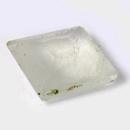|
Click on a letter above to view the list of gems. |
|
|
|
|
|
|
|
|
Glauberite |
|
| | |
| Discovered in 1808; IMA status: Valid (pre-IMA; Grandfathered). | ||
|
| ||
|
Chemistry |
| |||||||||||||||||||||||||
|
| ||||||||||||||||||||||||||
|
Na2Ca(SO4)2 | ||||||||||||||||||||||||||
|
|
Sodium Calcium Sulfate | |||||||||||||||||||||||||
|
Molecular Weight: |
278.18 gm | |||||||||||||||||||||||||
|
Composition: |
| |||||||||||||||||||||||||
|
|
||||||||||||||||||||||||||
|
|
||||||||||||||||||||||||||
|
|
||||||||||||||||||||||||||
|
|
|
Classification |
|
|
| |
|
Sulfates | |
|
6/A.08-40 | |
|
|
7 : SULFATES (selenates, tellurates, chromates, molybdates, wolframates) |
|
Related to: |
n/a |
|
Synonyms: |
Glauber's Salt |
|
|
|
|
Crystal Data |
|
|
|
|
|
Crystals, to 10 cm, tabular on {001}, prismatic along [101] with dominant {111} or along [001] with dominant {110}, or dipyramidal with dominant {111}, {110}; {001} and {111} may be striated k mutual intersections, yielding steplike terminations. |
|
|
None |
|
|
|
|
|
Physical Properties |
|
|
|
|
|
[001] Perfect, [110] Imperfect |
|
|
Conchoidal |
|
|
Brittle |
|
|
2.5 - 3.0 |
|
|
2.75 - 2.85 (g/cm3) |
|
|
None |
|
|
Not Radioactive |
|
|
Other: |
Slightly saline taste; powdery surface alteration in humid environments, leaching Na2SO4 and leaving gypsum. Very slightly soluble in water. |
|
|
|
|
Optical Properties |
|
|
|
|
|
Gray, pale Yellow, Colorless; Colorless in transmitted light |
|
|
Transparent to Translucent |
|
|
Vitreous to Waxy; Pearly on {001} cleavage surfaces |
|
|
1.507 - 1.536 Biaxial ( - ) |
|
|
0.0220 |
|
|
Strong; r > v |
|
|
X = colorless; Y = colorless |
|
|
|
|
|
Occurances |
|
|
|
|
|
Geological Setting: |
A common constituent of continental and marine evaporite deposits; as sublimates around fumaroles; in mineral-filled cavities in basaltic lava; in nitrate deposits in arid climates. |
|
Common Associations: |
Anhydrite, Gypsum, Halite, Mirabilite, Polyhalite, Thénardite (evaporites); Thénardite, Sassolite (fumaroles); Blödite, Thénardite (nitrate deposits). |
|
Co-type Localities: |
El Castellar mine, Villarrubia de Santiago, Ocaña, Toledo, Castile-La Mancha, Spain |
|
Year Discovered: |
1808 |
|
View mineral photos: | |
|
|
|
|
More Information |
|
|
|
|
|
| |
|
|
|
|
Glauberite is often pseudomorphed or cast by other minerals. Pseudomorph means "false shape" and occurs when a mineral is replaced by another mineral at such a very slow rate, essentially atom by atom, that no deterioration of the original shape of the crystal occurs. The resulting crystal retains the shape of the original mineral crystal but has the composition of the new mineral. A cast occurs when other minerals grow over an existing crystal then the original crystal completely dissolves, leaving a cast of the shape of the original crystal. The crystal habit, or shape, of a Glauberite crystal is unique enough that its pseudomorphs and casts can often be identified as being from a Glauberite crystal. Glauberite is soluble in water which is why it often creates casts. Notable occurrences of
Glauberite include Saline Valley, Inyo County and Searles
Lake, San Bernardino County, California; Great Salt Lake, Utah, Texas, New
Mexico and Verde Valley, Arizona, USA;
Strassfurt, Germany; Russia; Kenya; Chile; Toledo, Spain; Salzburg,
Austria; France; Canada; Sicily and India.
Pseudomorphs and casts come from many of the previously mentioned
localities and from Paterson and Great Notch, New Jersey, USA.
|
|
|
We
have not photographed our Glauberite gems. Please
check back soon. |
